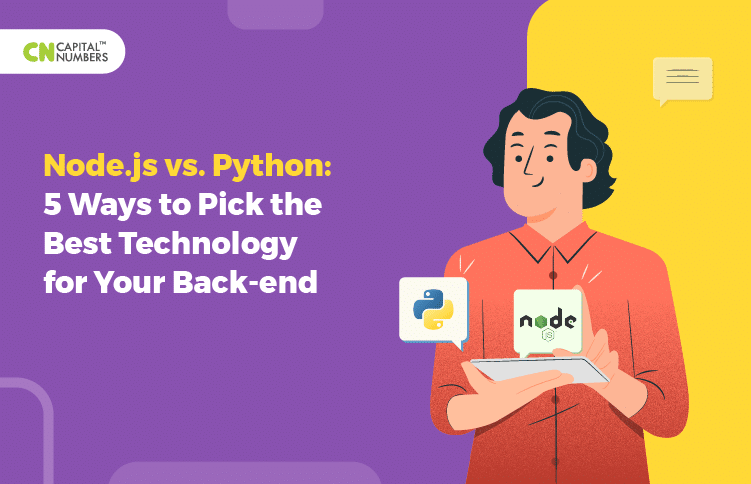Node.js vs. Python: 5 Ways to Pick the Best Technology for Your Back-end
Table of Contents
When deciding between Node.js and Python for your back-end development, it’s essential to evaluate each technology’s unique strengths. Both are powerful, widely used options, but the right choice depends on factors such as performance needs, scalability, team expertise, and the specific requirements of your project. Whether you’re building high-performance applications or dealing with complex data processing, understanding how each technology aligns with your project goals is key to making the best decision.
Not sure where to begin? We’ve got you covered! In this blog, we’ll explore and compare both technologies, examine their use cases, and highlight key differences, so you can confidently choose the best fit for your project. Let’s dive in.
What is Node.js?
Node.js is a free, open-source platform for running JavaScript on the server. It’s built on Chrome’s V8 engine, making it fast and efficient. Due to its asynchronous, event-driven architecture, Node.js is good for building real-time applications like chat apps and live data streaming.
Key Features of Node.js:
- Asynchronous & Non-blocking: Handles multiple requests at once without waiting for one to finish first.
- Single Language (JavaScript): Uses JavaScript for both client-side and server-side code, streamlining development.
- High Performance: Built on the V8 engine, it compiles JavaScript directly into machine code for fast execution.
- Real-time Data: Perfect for apps that require live updates, such as messaging and gaming apps.
- Scalable: Handles many simultaneous connections with minimal overhead.
- Rich Ecosystem: With Node.js packages available via npm, developers can easily add functionality to their apps.
What is Python?
Python is an easy-to-learn, high-level programming language known for its simple syntax and readability. It follows the object-oriented programming paradigm, making it versatile and easy to maintain. Python is ideal for web development, data analysis, automation, and more.
Key Features of Python:
- Extensive Libraries: Python has many useful libraries, like Django for web development, NumPy for scientific computing, and Pandas for data analysis.
- Cross-Platform: Python works on multiple operating systems, such as Windows, Linux, and macOS, making it flexible.
- Interpreted Language: Python executes code line-by-line, making it easier to debug and test.
- Dynamic Typing: You don’t need to specify the type of variable, making it faster and more flexible to write code.
- Large Community Support: Python has a big community that constantly adds new tools and offers help through forums and tutorials.
Struggling to build scalable and high-performance applications? Hire Node.js developers to create efficient, real-time solutions that drive your project forward.
Performance Evaluation of Node.js and Python
Although both Node.js and Python are used for back-end development, their performance varies depending on the use case. Here, we will compare these technologies based on key performance factors.
1. Nodejs vs. Python: Performance and Speed
High performance and speed are the primary features of web and mobile apps. No matter the type of app you’ve decided to create, these two factors can make or break the product.
Node.js
- With the help of non-blocking, event-driven architecture, Node.js can process several requests simultaneously and speed up code execution.
- Between Node.js and Python performance, Node.js allows you to code outside the web browser using TCP sockets, making it more resource-efficient.
- Node.js development enables caching of fetched data that is unlikely to change. It causes higher speed than Python web development.
- As you can run JavaScript code on the Google-invested v8 engine, Node.js apps’ performance and responsiveness are remarkable.
Python
- Python uses a single code flow. So it can process requests comparatively slowly.
- Python has an innate architecture that restricts it from multithreading.
- Python can be a major letdown if you want a quick data recall from the server.
- Also, it’s not ideal if you prioritize performance and speed in your app with complex calculations.
So, here, Python is the winner.
2. Node.js vs. Python: Scalability
Scalability defines the linear growth of resources required with an increase in app functionalities. It should not be an afterthought but a factor for choosing your back-end language right from the get-go.
Node.js
- Node.js frameworks facilitate multithreading via its asynchronous architecture, leading to easy scalability.
- Rather than a solid core like Python, Node.js uses a set of modules and microservices for its functionalities. So, scaling the app means the incorporation of a few modules.
- Node.js allows you to scale both vertically and horizontally.
- Node gives you more options in terms of typing. You can choose strongly-Typed TypeScript or weakly-typed JavaScript.
Python
-
- A significant drawback of Python is its use of the Global Interpreter Lock, which does not support multithreading. Though scalability can be increased with imported libraries, it can’t combat the innate scalability of Node.js.
- Python is dynamically-typed, meaning it’s not a better programming language for large-scale projects with increasing development needs.
- As the Python system grows, it becomes unnecessarily complex and difficult to maintain.
Node.js beats Python when it comes to scalability.
3. Node.js vs. Python: Universality
It means the number of different applications a programming language supports. It is difficult to judge which is “more universal,” Python or Node.js, as both have many use cases and can be helpful across multiple platforms.
Node.js
-
-
- Node.js is a JavaScript tool that allows you to craft front-end and back-end development with the same programming language. So, it is efficient in terms of resources.
- As it has cross-platform functionality, you can use the same desktop app on Windows OS and Mac. Linux.
- Node’js has many use cases – web apps, mobile apps, and cloud and IoT solutions.
-
Python
-
-
- Python is also universal, as you can use it for front-end and back-end development.
- It enables cross-platform usage. Mac and Linux come with pre-configured Python, but you must install a Python interpreter for Windows.
- Python would be the top choice for IoT and Natural language Processing, but not so much for Python mobile app development.
-
When you consider the universality between Node.js and Python, both go neck and neck.
You May Also Read: Vue.js vs. React.js: How to Choose the Right JavaScript Technology
4. Node.js vs. Python: Architecture
Architecture is another vital factor when picking up your back-end development technology. Generally, it is the standard approach to abide by the language or framework/environment.
Node.js
-
-
- Node.js is event-driven. Both its input and output are asynchronous, causing a fast development process. So, it is the ideal choice for web games and chatbots.
- It can process many requests simultaneously without blocking the thread and at an incredible speed.
-
Python
-
-
- As Python is synchronous, it is slow. So, you may not pick this language if your project is like a chatbot. But you can leverage the Python Asyncio library to run parallel processes.
- It is not event-driven. Also, you can make it event-driven using modules like CPython.
-
As Node.js is asynchronous, event-driven, and has non-blocking architecture, it scores higher than Python.
5. Node.js vs. Python: Extensibility
The more data structures, frameworks, and functions you can tack onto the base platform, the more robust the functionality is.
Node.js
Every day, a new framework or tool poops up with Node as a base. The most widely used ones are
-
-
- Babel – for front-end development
- Jasmine- for testing
- Log.io – for project management
-
Python
The great extensibility and many web development frameworks make Python an excellent choice for back-end development.
-
-
- Robot – for acceptance level testing
- Flask – for web development
- Web2py – for agile development of data-driven web apps
- Django – for back-end development
-
Both Node.js and Python perform well in extensibility.
You May Also Read: Django, Flask, FastAPI: A Comparative Analysis of Python Web Frameworks
Node.js vs. Python: Comprehensive Comparison
Want to know about the differences between Node.js and Python at a glance? Here it is for you:
| Feature | Node.js | Python |
| Performance | Faster for I/O heavy tasks, non-blocking | Slower for I/O tasks, better for CPU-heavy tasks |
| Learning Curve | Easier for JavaScript developers | Easier for beginners due to simple syntax |
| Concurrency | Event-driven, handles concurrent requests well | Uses multi-threading, better for parallel tasks |
| Real-time Applications | Ideal for real-time apps like chat, gaming | Can be used, but less efficient for real-time |
| Community & Libraries | Large ecosystem, NPM | Extensive libraries, especially for data science |
| Web Frameworks | Express.js, Koa | Django, Flask, FastAPI |
| Stability for Data Science | Not commonly used | Strong support for data analysis and AI |
What Are the Top Apps Built with Node.js?
Various top applications are built with Node.js for its speed and efficiency. Here are some notable ones:
1. Netflix
Netflix uses Node.js to improve the performance of its streaming platform. It helps handle many user requests at once, ensuring smooth streaming and quick content delivery to users worldwide.
2. LinkedIn
LinkedIn switched to Node.js for its mobile app to make it faster and more efficient. Using Node.js, the platform reduced server load and improved real-time updates for users.
3. Uber
Uber uses Node.js to power its real-time ride tracking and matching system. This helps Uber handle many users at once, ensuring that riders and drivers are quickly matched with minimal delays.
4. PayPal
PayPal adopted Node.js to speed up its platform’s performance. The use of Node.js helped reduce development time and allowed the front-end and back-end teams to work together more effectively.
5. Trello
Trello uses Node.js for real-time collaboration features. Node.js helps manage live updates and interactions on boards, making it easier for teams to work together and see changes instantly.
What Are the Top Apps Built with Python?
Many top apps are built with Python for its simplicity and versatility. Here we have listed a few for you:
1. YouTube
YouTube uses Python for various back-end services, including video processing and recommendation algorithms. Python’s powerful libraries and efficiency in handling data-heavy tasks help YouTube manage billions of videos and user interactions smoothly.
2. Instagram
Instagram uses Python for its back-end, enabling it to handle millions of users and vast amounts of data. Python’s scalability and simplicity make it a great fit for building a feature-rich platform.
3. Spotify
Spotify relies on Python for data analysis, machine learning, and back-end services. Python helps process user preferences and delivers personalized content to millions of users worldwide.
4. Reddit
Reddit was initially built using Python, and it continues to use the language to handle its large, active user base. Python helps Reddit scale while maintaining performance.
5. Pinterest
Pinterest uses Python to process large datasets and power its image recognition and recommendation algorithms. Python’s rich libraries and ease of use make it ideal for Pinterest’s data-driven platform.
Node.js vs. Python: When to Use What?
Finding it difficult to decide which technology to use for your project? Here’s a quick overview of when to choose Node.js or Python for the back-end.
When to Use Node.js:
- Real-time applications (e.g., chat apps, gaming)
- API development
- Streaming applications
- Single-page applications (SPAs)
- IoT applications
- Lightweight and fast services
- High-concurrency applications (e.g., social media platforms)
- Microservices architecture
- Data-heavy applications with high I/O performance
When to Use Python:
- Data-heavy applications (e.g., data analysis, AI, machine learning)
- Web development with Django or Flask
- Scientific computing and research
- Integrating with data visualization tools
- Game development (using libraries like Pygame)
- Scripting and automation tasks
- Prototyping and quick development
- Applications with complex computation and CPU-bound tasks
- Backend development for scalable systems
You May Also Read: PHP vs Node.js: Which is Better for Web Development in 2025?
Bottom Line
The choice of technology plays a vital role, especially when developing an application that can help boost your business. The decision between Node.js and Python depends on the specific requirements and features that you want in your applications. Both have pros and cons, so it’s important to evaluate which best fits your project’s needs.
Ultimately, choosing the right technology will ensure your application is scalable, efficient, and aligned with your business objectives. Once you have decided on the technology, opt for Node.js or Python development services to ensure expert implementation and set your project up for long-term success.















